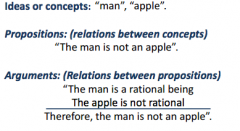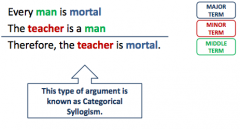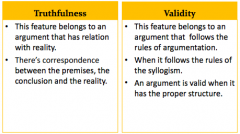- Barajar
ActivarDesactivar
- Alphabetizar
ActivarDesactivar
- Frente Primero
ActivarDesactivar
- Ambos lados
ActivarDesactivar
- Leer
ActivarDesactivar
Leyendo...
Cómo estudiar sus tarjetas
Teclas de Derecha/Izquierda: Navegar entre tarjetas.tecla derechatecla izquierda
Teclas Arriba/Abajo: Colvea la carta entre frente y dorso.tecla abajotecla arriba
Tecla H: Muestra pista (3er lado).tecla h
Tecla N: Lea el texto en voz.tecla n
![]()
Boton play
![]()
Boton play
![]()
12 Cartas en este set
- Frente
- Atrás
|
Logic
|
Logic is the philosophical discipline in charge
of studying the structure of correct thinking and helps us differentiate between correct and incorrect arguments. Through this science, we can think properly and, then, reach the truth of our reality. |
|
Logic's Etimology
|
“Logic” comes from logos: word,
discourse, thinking; and ica: in reference to. Etymologically speaking, logic means “in reference to thinking”. |
|
Creator of the science of logic
|
Aristolte. For Aristotle logic is the tool that allows
us to make science and to know the reality. |
|
Aristotle's Logic
|

The thinking is formed by: ideas (or concepts), propositions (relations between concepts) and
arguments (relations between propositions). |
|
Argument Structure
|

Argument: any group of propositions, of which it is said
that one is the consequence of the others. |
|
Inference (structure of an argument)
|

Inference: take as a starting point a group of propositions and reach a conclusion according to them.
|
|
Premises (structure of an argument)
|

Premises: are the propositions that work as a starting
point. |
|
Conclusion (structure of an argument)
|

It's the preposition that follows the premises.
|
|
Major, Minor and Middle Terms (structure of an argument)
|

|
|
Logical reasoning
|
is a necessary tool for understanding the world.
|
|
Logical thinking
|
consists in following an "orderly thinking".
|
|
The 2 features in an argument
|

Truthfulness and Validity
|